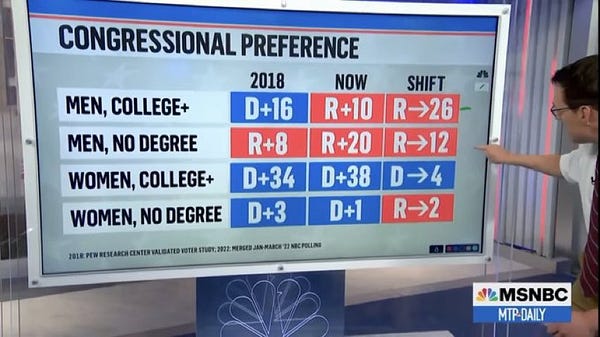Many are sharing this tweet, and pointing out the difference between genders in party preference. To summarize, there is a clear divide between men and women in terms of which party they support, with men more likely to support the Republican Party and Women more likely to support the Democratic Party.
This difference is now new. In fact, as this PEW research report shows, the gap has existed for decades and has been widening since 2015. However, the pandemic appears to have supercharged it, with now a whopping 48% divide among college-educated men and women and a 21% divide between the non-college-educated. But why did this happen, and does this have anything to do with this poll’s (and many others) finding that women are/were more concerned about the virus overall?
What follows is not based on specific research I have done or read. However, I have a theory about why this is happening and it lies a bit deeper than many would think.
First, let’s take a look at this study on personality differences between men and women. While there are several personality models, the study uses the Big Five model, which proposes that personality can be summarized along five dimensions: Openness, Conscientiousness, Extraversion, Agreeableness, and Neuroticism (OCEAN). As the study shows, it is well-established in Psychology literature that there are differences between men and women in those five dimensions, some bigger than others. But which ones show the biggest differences? Here lies our answer.
Women score higher than men in agreeableness, which “involves the tendency toward cooperation, maintenance of social harmony, and consideration of the concerns of others”. Women score higher in conscientiousness, which “appears to reflect the ability to exert self-control in order to follow rules or maintain goal pursuit”. Women score higher in neuroticism, which “describes the tendency to experience negative emotion and related processes in response to perceived threat”. These are the themes we have heard over and over from the “experts” and the media. Specifically, we were told that we needed to cooperate, maintain social harmony, and be considerate of the concerns of others. We were told to follow rules. We were told that there was a significant threat to our well-being.
It is no surprise that women were more receptive to these messages than men were. After all, we are “social animals” and while we like to think we exercise free-will, some of our behaviors are determined by psychological forces deeply engrained inside our brains. I believe this led to an environment in which women were more concerned about the virus than men and were more receptive to the demands from public health that we should try to minimize its spread to others. As a result, Democratic Party’s messages resonated much better with females than they did with males.
As I am typing this in an outdoor playground, I see the one person with a mask, who is unsurprisingly a female…





